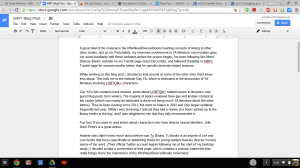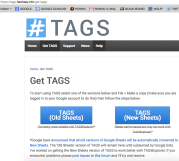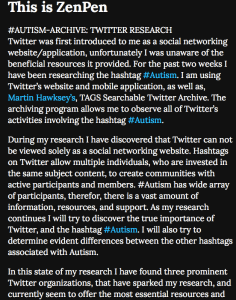ZenPen: Reflection
Kim’s Reflections on Google Docs and Draftback

I’ve been using Google Docs to compose writing since 2011. It’s by far my favorite writing tool, and I use it virtually every day. Since I can use it on my phone, Chromebook, and Android tablet, it’s incredibly convenient. It also has a nice layout and multiple different ways for me to adjust the text size, color, etc. to my liking. I also like that the background in the “print layout” view is a pale grey, which is easy on my eyes. Basically, it’s my ideal writing tool and I use it whenever I can, and I’m glad it came to my attention when it did. (I have years of writing stored on my Google Drive!)
Unless told to do otherwise, I write anything and everything in here, from paragraph-long responses to, on one occasion, a 150-page NaNoWriMo project. The infinite space that Google Docs allows makes its uses limitless. It’s so much easier to write on here than anywhere else because I can go back and edit what I need to edit by scrolling or using ctrl + f on any device. I could do this on Microsoft Word as well, but not from my phone!
After composing in here, I copy everything, paste it into WordPress (or, for my personal blogs, Blogspot), and add images and links as I see fit before publication. I only really use Drive for drafting purposes if something is going to be published online.
When I watched the Draftback of my blog post, I was surprised that it had as many revisions as it did (though most of those were individual keystrokes). I learned that I often add a lot of information in the beginning of a post that I cut before publishing, and that I make a lot of revisions while I’m still typing (changing word choices, correcting typos, etc.) I’m a linear writer, but I often jump around to fix things while I’m working.
Aside from being one of the coolest things I’ve ever witnessed, the Draftback of my blog post draft showed me a lot of things about my writing process that I otherwise never would’ve thought about. I might set these up for some of my longer writing assignments and personal projects, now that I think about it…
Watch it here!
http://draftback.com/embed/cce3c940c31ef4e8523553753c69d5ab?autoplay=true
Blog Post #2 – WeNeedDiverseBooks and Its Associated Websites
A great deal of the material in the #WeNeedDiverseBooks hashtag consists of linking to other sites, books, and so on. Fortunately, my extensive involvement in YA literature communities gave me some familiarity with these websites before the project began; I’ve been following We Need Diverse Books’ website on my Tumblr page since December, and followed Disability in Kidlit’s Tumblr page for several months before that for specific diversity-related reasons.
While working on this blog post, I decided to look around at some of the other sites that I knew less about. This took me to the website Gay YA, which is dedicated to the discussion of YA literature involving LGBTQIA+ characters.
Gay YA’s site contains book reviews, posts about LGBTQIA+ related issues in literature, and guest blog posts from writers. The majority of books reviewed have gay and lesbian content at the center (which can mainly be attributed to there not being much YA literature about the other letters). They’ve been running since 2011, but went on hiatus in 2012 and only began updating frequently last year. While I was browsing, I noticed they had a review of a book I picked up at the library earlier in the day, and I was delighted to see that they fully recommended it.

Another site I didn’t know much about before was Tu Books. Tu Books is an imprint of Lee and Low books that focus specifically on publishing books for young readers that are diverse in every sense of the word. (Their official Twitter account began following me at the start of my hashtag study.) I decided to take a screenshot of their page, which contains a mission statement that really brings home the importance of the #WeNeedDiverseBooks movement.

How cool is that? (I may or may not have pre-ordered some of their titles after reading that…)
After looking at some of these sites, I learned a few things. Primarily, I learned that the #WeNeedDiverseBooks community is, indeed, very diverse. Its members are of all different races, sexualities, disabilities, and more. However, one thing I noticed is that though they all want diverse books, there’s still not much discussion of intersectional diversity.
Since I’ve used this term often, let me explain: A book dealing with intersectional diversity would involve a character who is a member of two or more groups who would be considered “diverse.” (A book with a character who is black and dealing with depression would be intersectionally diverse.) Each site seems to be discussing books about one specific kind of diversity, and they don’t often interact with one another.
There’s probably a good reason for this. This post by Malinda Lo illustrates the problems some reviewers have with books that are diverse. In the third section of the post, she describes the problems that books containing intersectional diversity face in the hands of reviewers. Since they’re more likely to be reviewed in a lukewarm manner, publishers tend to shy away from books with more than one sort of “difference” involved… so there’s not as much to talk about.
I’m a little disappointed by this. There’s so much conversation that could be happening! I guess it’s time for the industry to change…
#Autism-Archive: Twitter Research

Twitter was first introduced to me as a social networking website/application, unfortunately I was unaware of the beneficial resources it provided. For the past two weeks I have been researching the hashtag #Autism. I am using Twitter’s website and mobile application, as well as, Martin Hawksey’s, TAGS Searchable Twitter Archive. The archiving program allows me to observe all of Twitter’s activities involving the hashtag #Autism.

During my research I have discovered that Twitter can not be viewed solely as a social networking website. Hashtags on Twitter allow multiple individuals, who are invested in the same subject content, to create communities with active participants and members. #Autism has wide array of participants, therefor, there is a vast amount of information, resources, and support. As my research continues I will try to discover the true importance of Twitter, and the hashtag #Autism. I will also try to determine evident differences between the other hashtags associated with Autism.
In this state of my research I have found three prominent Twitter organizations, that have sparked my research, and currently seem to offer the most essential resources and positive influences: @AutismNewsNow, Autism Life: @Autismword (who has the most tweets using the hashtag #Autism), and @KidConnectionZ.
Follow me @AdamCGoscinski, to view any updated information as my research continues.
Kim’s Reflections on ZenPen
ZenPen was a different sort of writing tool. With its vast white spaces and lack of features, it was like an alien version of the other softwares I’ve used. It has all of the necessities of a good writing space, but somehow, something about it felt off to me.
My first issue was the look of it, the sheer amount of whitespace on the screen and the size of the text. I have sensory integration issues, so looking at a blank white screen is actually painful for me if I do it for too long. (This makes it hard to be a writer sometimes without dimming the screen significantly.) I didn’t play around with the features enough to discover that there’s a way to invert the colors, but I’ll admit that, now that it’s been pointed out to me, it does help a lot.


The font issue is merely a matter of me being ridiculously picky. I don’t like sites where the text isn’t 11 or 12-point font because I can’t see as much at once. There’s a benefit to this, of course, but for me it’s just frustrating.
As for it causing minimal distractions because of its lack of features, well… allow this screenshot to say my thoughts.
Returning to ZenPen for a re-appraisal, however, I found a bit more to like about it. Not being able to check my word count without setting a goal is still annoying, but everything else is sort of interesting. It’s hard to figure out what kind of writing to do on the site: it’s definitely not suited for writing a novel, of course, and it doesn’t have enough features to make for an ideal place to compose essays for school.
However, if you’re looking to jot down words quickly, it’s not a bad choice. On ZenPen, it’s not hard to reach your word count in a short amount of time if you jump into full screen and just keep tapping keys. It could be a good place to punch out a quick draft of a blog post or essay questions. It may even be ideal for beginning a short story if you just want to get to writing right away. The hardest part of writing is starting, and ZenPen makes it very easy to start.
I think I’m going to keep working with ZenPen every so often. It has potential to be very useful to me if I can get past my problems with the way it looks.
#WeNeedDiverseBooks: Analysis of a Hashtag
#WeNeedDiverseBooks is a big deal in literature for youth, but its hashtag is a bit less of a community than I expected.

In the past two weeks of tracking the tag, the hashtag has been used in 5,317 different tweets. (This data is based on modifications I made to only track tweets from accounts with 20 or more followers, since many accounts with fewer have spammed the tag in the past.)The user who tweets the most is MadhuriBlaylock, who has used the hashtag 1,271 times in the past two weeks. (She has also retweeted one of my usages of the tag.) After that, the users with the next highest number of tweets using the hashtag had fewer than fifty instances.
Most of what is discussed in the tag is sharing and re-sharing of articles related to diversity in literature. Since it is Black History Month, a lot of the tweets have to do with African-American literature.

Unfortunately, there is not a lot of conversation going on in the tag. Most of these tweets are just people sharing articles, without retweeting others or adding anything to the conversation. The TAGSExplorer graph for my archive shows that there are many people using the hashtag, but most of them aren’t talking to each other. The user who started the biggest conversation that’s visible on the graph so far has only had their tweet retweeted many times.In conclusion,
I’m a bit surprised that there’s not a lot of dialogue going on about #WeNeedDiverseBooks within its hashtag. Maybe I have to get some started, then!
A Proposal for Studying #WeNeedDiverseBooks
The hashtag I am choosing to study is #WeNeedDiverseBooks.
The hashtag was first used about a year ago by librarians and authors throughout the country. Children’s and young adult literature is overpopulated by characters who are predominantly white, heterosexual, cisgender, able-bodied, neurotypical, thin, and other things that many individuals consider to be the “norm.” As a result, books with characters outside of that norm are often ignored by publishers. While there’s nothing wrong with those books just because they aren’t diverse, they indirectly keep the publishing industry from changing. Since the world is changing and people are becoming more diverse, many people believe that children of diverse backgrounds aren’t being served by their literature. #WeNeedDiverseBooks is a cry for authors and publishers to write and publish books that portray more diverse worlds. It’s proven very successful; greater attention is being given to books that have characters from all backgrounds.
I’m interested in studying this hashtag because I am hoping to one day write for a young audience, and anything in the young adult literature community is a point of great interest to me. I also grew up with a disability, and suffer from depression and anxiety. Many people in the #WeNeedDiverseBooks community believe that more books need to talk about mental health and all sorts of disabilities. Many books that feature such conditions are riddled with stereotypes and offensive connotations. With the increased push for diversity, this is slowly changing. I want to study this hashtag because I’m interested in learning even more about the community. It’s very active, and full of very interesting stories to tell. Plus, it’s actually getting things to change (slowly, over time).
I have a lot of familiarity with books and texts relating to #WeNeedDiverseBooks. I try to read as many books about many different kinds of characters as I can. I follow the ALA Youth Media Awards every year, and this was a huge year for diversity in those awards. It was a very exciting thing to witness people excited about change, and what’s more, a lot of these new diverse books are really great stories. On social networks, I follow blogs such as Disability in Kidlit (which discusses portrayals of disabled characters in children’s and young adult books), and Gay YA (which discusses books about characters who are gay, lesbian, bisexual, transgender, etc.).
The #WeNeedDiverseBooks hashtag gets hundreds of tweets every day. These are generally by librarians, authors, and publishers. It’s been especially active lately as a result of the Youth Media Awards, and with other ongoing controversies in the publishing industry, it doesn’t look like it will be slowing down anytime soon.
#LGBT Proposal
The research that I hope to conduct comes from the hashtag LGBT which is associated with The Lesbian, Gay, Bisexual &Transgender Community. I am interested in studying this hashtag because I feel that the rights of the LGBT community should be constantly recognized and promoted by any person who supports human rights. Many fail to realize the harsh criticism, bullying, backlash, and hate that, lesbian, gay, bisexual, and transgender individuals receive. Additionally, many of their supporters receive this criticism. By posting with this hashtag this community can spread love, raise awareness, and allow for a better understanding of a lifestyle that those in the LGBT Community were born into. I believe #LGBT to be a positive feed in which the LGBT community and their supporters can post their thoughts and feelings. Being able to relate to another person in a similar situation, in even the smallest way, can make a difference in someone’s life.
In my study, I hope to learn about the struggles that those in the LGBT community have faced and overcome, changes that can be made to create a more accepting society, steps that others have taken to support the community, and actions that I can take to make a difference. Although I may not always be able to relate to certain posts, it is important and insightful to realize the struggles that others are facing.
I am familiar with the #LGBT text, as a supporter of the community, a friend, and relative to members involved. I have further familiarized myself with the community by visiting websites, reading #LGBT tweets and tweets associated with it, and reading associated news articles, and finding media outlets that support the community. Other communities that are associated with this hashtag include, but are not limited to: The Human Rights Campaign, NOH8 Campaign, GLAAD, Gay Star News, and The LGF. Celebrities, activists, bloggers, and news outlets tweet using #LGBT on any given day. It is an extremely popular hashtag which continues to expand.
People are constantly tweeting the #LGBT. News updates, stories, experiences, and updates are constantly shared. Twitter allows for an easier, more accessible way for communication of subjects on this topic.
#Autism: Proposal

#Autism is a hashtag on Twitter, that has developed into an online community, constructed of diverse followers with a specific interest. “The National Autistic Society,” is an online organization that uses this hashtag to provide support, important articles, and discussion forums to members of the community.
During the summer I work as a para-professional, for a high school student with autism. From this experience I observed the positive influence technology can have on a student’s educational success; therefor, I have implemented the iPad into my lesson plans. I was recently introduced to the professional aspect of Twitter. Which lead me to discovering the hashtag, #Autism. There are autism experts, doctors, students, teachers, and parents tweeting key ideas for working with autistic children. Thanks to Twitter and the hashtag #Autism, multiple experienced perspectives can be found on the same news feed. As an elementary education major, I know I will be faced with teaching an inclusion class at some point in my career. The hashtag #Autism is a tool to help me prepare for that class. Not only can the hashtag influence my future success as a full time teacher, but it can positively shape my job in the summer. There is a vast variety of material tweeted, from a wide array of followers. Which means that there are multiple tweets every minute. I have a read many articles on autism, so I have some knowledge of the material/text. Though, there are still a few tweeted articles with too much professional jargon to understand. I personally feel that in most cases the simple worded explanation from a mother who has an autistic child, is more beneficial than the 10 page article posted by a doctor. The hashtag’s accessibility lies with the direct communication of information to a specified audience. The variety of followers, increases the success of the hashtag, as well as, the chance to find an answer/solution.




